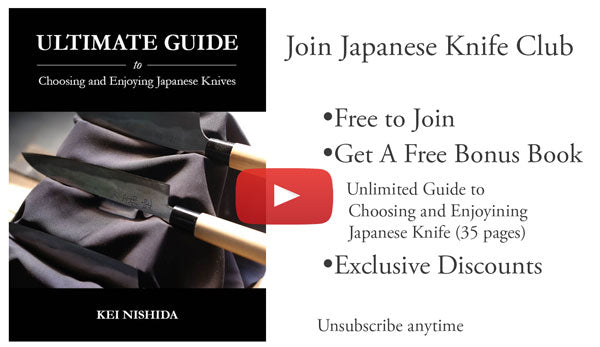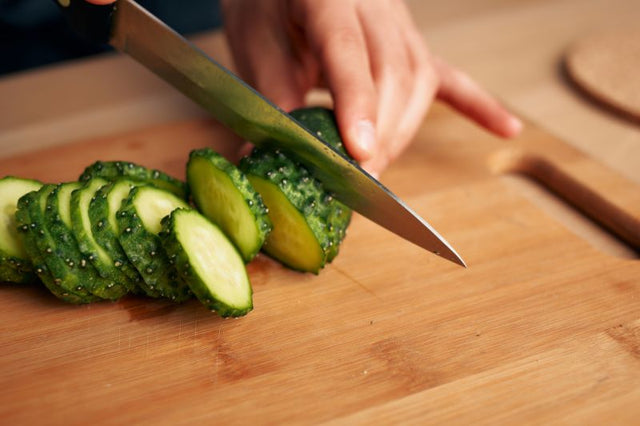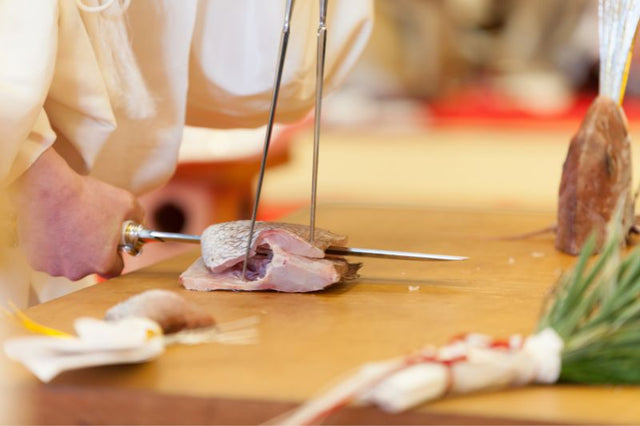After hours of online research and reading about different steels and designs, you've finally decided on the knife you want to buy. You check the front door every thirty minutes in anticipation of the arrival of your shiny new kitchen pal. Finally, it arrives! But, wait a minute, the box seems small - or much heavier than you expected. Uh oh.
Choosing the Correct Knife Size: The Structure of This Article
It can be devastating to get your dream knife, only to find out it's too small or too big. In this article, I will explain why getting the right size is essential. There's no definite way to know the exact right length and weight, as people come in many different shapes and sizes, but I'm going to give you several methods to help you make the right choice. And I'll share some easy ways to make a knife feel like it's a different size.
Why Do I Need to Worry About the Size of My Knife?
Foremost, To Avoid Repetitive Strain Injuries and Feel Comfortable
Not only can the wrong size be awkward to hold, but it can also be challenging to maneuver and put unnecessary strain on your arm and wrist. You may have used knives at other people's homes and found them awkward but not a big problem. However, when it's your own and you use it every day, it can become a long-term health issue. But with the correct size, you can chop for hours without any hand or wrist strain.

It Significantly Affects the Weight
The bigger the knife, the heavier it is. In some cases, extra weight is exactly what you want. For example, a butchery and filleting knife like a Deba should be heavier than your primary knife; it must be able to cut through bones, after all. However, if your knife is so large and heavy that you struggle to wield it, it will be useless. So, yes, get the big knives for big knife jobs, but remember, even heavy knives come in smaller sizes for a reason.
Shortness Mitigates Sharpness
You can have the sharpest knife in the world, but if it's so tiny and light that you have you push it through everything, or it doesn't reach all the way across vegetables, you'll quickly get frustrated at its inefficiency. If you have larger hands, you may also find that your knuckles hit the board when you chop with a knife that's too small for you. So save the small knives for precision work.
Using the Blade to Decide
Most people decide which primary knife is right for them by looking at the blade length. Usually, the measurement that retailers and manufacturers give is only the length of the blade (not the entire knife from the blade's tip to the bottom of the handle). This method can be a very effective way of knowing if it will be the right size for you, especially if you've used knives from the same manufacturer before.
The Average Length
In a sense, this is simple. The longer the blade, the bigger the handle, and the larger your hand needs to be. But what's considered large and small? Generally, 200 - 210mm (8 - 8.3 inches) knives are considered average length. For the majority, a knife with a blade of this length will be suitable, but there are some ways you can double-check.
Using Hand Length to Determine Blade Length
You can measure the length of your hand to check what size knife you should use. For example, according to NASA, the average length of a man's hand is 19.3cm (193mm or 7.6 inches). If you round this number up to the nearest blade length, you get the aforementioned average knife length, 200 - 210mm (8 - 8.3 inches).
How to Measure Your Hand’s Length
So, following the method above:
- Measure the length of your hand from the wrist line to the top of your longest finger.
- Then, round the number up to the nearest knife size. For instance, if your hand has a length of 17cm (170mm or 6.7 inches), then you can comfortably use a knife with a blade length of 180mm (7.1 inches).
It's not an exact science, but it gives you a good idea of whether or not a knife will suit you. But, be aware this method only works for choosing a primary knife such as a Gyuto, Bunka, or the standard Western chef's knife.

How Weight Changes Appropriate Size
All kitchen knives are more or less the same weight, right? Not exactly. The method above only works for primary knives for good reason. Take the Deba knife, for example. At 210 mm (7.6 inches) with its thick blade, it can weigh around 500g (1.1 lbs), whereas a Gyuto of the same length only weighs about 150g (0.33 lbs). That's an enormous difference, even though they're the exact same length.
How to Scale for Weight
So, unless you're regularly cutting up reasonably large fish, choose a heavy knife like a Deba one size down from your primary knife. For example, if your primary knife is 200 - 210mm (8 - 8.3 inches), you'll want a Deba around 180mm (7.1 inches). In this case, your hand length is rounded down rather than up.
An Exception to the Rule
Compared to Western knives, Japanese knives have much thinner blades. That means they're lighter in general. So, the good news is that if you need a primary knife that's a size bigger than your hand length determines, a more lightweight Japanese knife can still be relatively comfortable. Many professional chefs, for instance, prefer to have a larger size for bulk chopping.
Knife Techniques
Depending on how you use your knife, you can make it feel shorter or longer. That means if, for some reason, you have to compromise on the size of your knife (if you're sharing it with other family members, for example), then you can still use it effectively.
Pinch-Grip to ‘Shorten’ a Knife
A pinch-grip will easily make a long knife more manageable. It's also great for blade-heavy knives, which Japanese knives with a traditional handle (wa) tend to be. Pinch your forefinger and thumb above the blade's heel and wrap the rest of your hand and fingers around the handle. Immediately, you will have more control over the blade, and the weight will be better distributed.

Rock to ‘Lengthen’ and ‘Lighten’ a Knife
Rocking (sometimes just called slicing, rock-slicing, or rock-chopping, although the latter can also refer to rough-chopping) will make a heavy knife feel lighter and give a smaller knife better leverage. Put the blade's tip on the board and slide the knife's heel up and down to slice things. Your non-dominant hand should hold the object with your fingers tucked in like a claw and your knuckles against the blade.

Because the blade is always in contact with the board using this technique, it'll take a lot of the weight out of the knife. As a result, it'll make a long knife feel a lot lighter. However, note that this only works for curved blades.
Knife Size and Type Chart
If you know what type of knife you want, here is a handy chart of what sizes of knives are available based on the blade length.

And here are the links to those knives above.
Japanese Style
Western Style
Additional Considerations
How Big is Your Kitchen?
If you only have a small space to cook in and little storage space, it can be worth getting a size smaller than your hand measurement might indicate. After all, having a long knife is pointless if your elbows keep hitting things behind you.
Who Else is Using the Knife?
If someone else in your household also does cooking, and you're kind enough to share your fancy new knife with them, it's also a good idea to measure their hands. You can compromise and get a size between what you both require and then use one of the knife techniques above to make the knife feel suitable.
What Are You Cooking?
As I said earlier, measuring hand length will only work for primary knives such as a Gyuto. But for everything else, the question is, what are you cooking? For example, if you typically fillet very large fish, you may need an exceptionally large Deba. On the other hand, if you're trying to slice garlic super-thin, the smallest Petty knife might be what you want.
How Do the Knives You Already Own Feel?
Measure the blades of the knives you already own and then hold them. What do you like about them? What do you dislike? Do they feel too long or too heavy? Would a lighter Japanese-style handle feel better? Think about how your current knives make you feel as you use them.
Get Free Bonus Books

Sign up for free to the Japanese Knife Club to get advice and exclusive articles about how to choose Japanese Knives, and tips and tricks for using Japanese knives.
About the author
Kei Nishida
Author, CEO Dream of Japan
Certification: PMP, BS in Computer Science
Education: Western Washington University
Kei Nishida is a passionate advocate of Japanese craftsmanship, a writer, and the founder and CEO of Japanese Knife Co., Japanese Green Tea Co., and Japanese Coffee Co., all part of Dream of Japan.
His journey began with a mission to introduce the world to the exquisite flavors of Japanese green tea. Through Japanese Green Tea Co., he pioneered the import of premium tea grown in nutrient-rich sugarcane soil, earning multiple Global Tea Champion awards. He then expanded into the world of coffee, launching Japanese Coffee Co., the first company to bring Sumiyaki charcoal-roasted coffee to a global audience.
With a deep appreciation for Japanese artistry and tradition, Kei turned his attention to one of Japan’s most revered crafts: bladesmithing. Through Japanese Knife Co., he made handcrafted katana-style knives, created by a renowned katana maker, available outside Japan for the first time. These exceptional knives embody centuries of samurai sword-making expertise, blending tradition with modern functionality for chefs and collectors alike.
Kei’s journey continues as he uncovers and shares Japan’s hidden treasures—one sip, one blade, and one legacy at a time.



















Thank you so much for your thoughtful comment and for pointing out the history behind the santoku — you’re absolutely right that the santoku is very much a Japanese knife, developed in the Kansai region and named for its “three virtues.”
In our article, when we refer to the santoku as “Western,” we’re specifically talking about the handle style, not the cultural origin of the blade itself. Many santoku knives today are produced with a Western (yo) handle — the heavier, full-tang handle style also commonly seen on German and French chef knives. Meanwhile, the version with the lighter, traditional Japanese (wa) handle is what we refer to as the “Japanese-style” santoku in the chart.
So the santoku blade shape, philosophy, and history are absolutely Japanese — the distinction we’re making is simply in the handle construction.
We truly appreciate you taking the time to comment and share your knowledge — it’s a great reminder to clarify wording so readers understand the difference between blade style vs. handle style. I’ll update the article to make this clearer so it doesn’t imply the santoku has Western origins.
Thank you again — conversations like this make the community stronger.
So I noticed that you have the santoku knife labeled as western in stead of Japanese,why exactly when it is indeed a Japanese style knife not a western most western knives are identical in physical appearance to German except steel composition and their handle design and construction and the fact that santoku means 3 virtues which refers to its 3 purposes in japanese. Not to mention the design was created and crafted in the Kansai region of Japan in the 1940s as a contrast comparison of the western chef knife seen being used by u.s. troops in world war 2 to prepare food